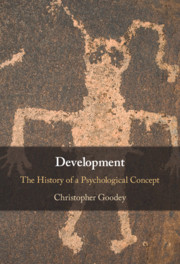Book contents
- Development
- Development
- Copyright page
- Contents
- Acknowledgements
- Introduction
- Chapter 1 Development and the Origin of Psychological Concepts
- Chapter 2 The History of Christianity and the First Principles of Development: Linear Time, Interiority, Structure
- Chapter 3 The History of Education: Rearing the Elect Child
- Chapter 4 Pascal on the Ordering of Human Time
- Chapter 5 The Normalization of the Elect: Locke to Montesquieu
- Chapter 6 The Coining of a Developmental Theory: Leibniz to Bonnet
- Chapter 7 Emile: Rousseau’s Well-Ordered Developer
- Chapter 8 Nature versus Nurture and Cognitive Ability Testing: Historical Sketches
- Postscript Further Targets for Historical Research
- Index
Chapter 3 - The History of Education: Rearing the Elect Child
Published online by Cambridge University Press: 10 June 2021
- Development
- Development
- Copyright page
- Contents
- Acknowledgements
- Introduction
- Chapter 1 Development and the Origin of Psychological Concepts
- Chapter 2 The History of Christianity and the First Principles of Development: Linear Time, Interiority, Structure
- Chapter 3 The History of Education: Rearing the Elect Child
- Chapter 4 Pascal on the Ordering of Human Time
- Chapter 5 The Normalization of the Elect: Locke to Montesquieu
- Chapter 6 The Coining of a Developmental Theory: Leibniz to Bonnet
- Chapter 7 Emile: Rousseau’s Well-Ordered Developer
- Chapter 8 Nature versus Nurture and Cognitive Ability Testing: Historical Sketches
- Postscript Further Targets for Historical Research
- Index
Summary
In the seventeenth century there was still no clear distinction between the child’s interiority and the adult’s, since ‘saving’ grace could arrive at any point in the lifespan. However, a rudimentary developmental idea was already defining the category of childhood more sharply by calendar age. This becomes clear in the principles behind the experimental primary schools established by the Jansenist wing of French Catholicism, including figures such as Antoine Arnauld and the Abbé de Saint-Cyran, as an alternative to Jesuit education. The Jansenist schools aimed at preserving the purity of children assumed to be elect (i.e. those of their own families) from contamination by the surrounding mass of reprobates in thrall to the Devil. The educational method was precisely not religious instruction but a secular, humanist curriculum based on reason. This went hand in hand with close control of the children in a panopticon; school discipline switched from physical punishment to moral shaming. The history of education as an academic discipline shows an unwitting bias towards being a history of the elect child.
Keywords
- Type
- Chapter
- Information
- DevelopmentThe History of a Psychological Concept, pp. 69 - 84Publisher: Cambridge University PressPrint publication year: 2021

